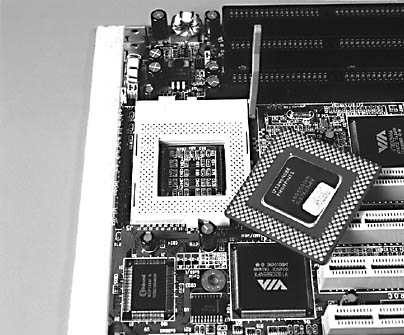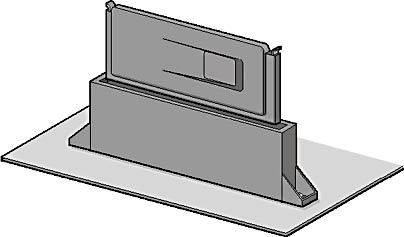- Low-insertion force (LIF).
- Zero-insertion force (ZIF).
- Single-edge connector (SEC).
LIF Socket
Removing an old CPU from a LIF socket is a muscular business! Luckily, there are special tools that are designed for this. However, a flat-head screwdriver, or a plate cover for an expansion card slot, will also work-just be sure to pry evenly around the CPU or you will risk damaging the CPU, the socket, or both.
NOTE
There is a notch in one corner of a LIF socket. The CPU will also have a notch and a dot in one corner, designed to help align the CPU correctly. The index corner of the CPU must line up with the notch on the socket. Firmly press the CPU into the PGA socket, making sure all the pins are lined up.
ZIF Socket
The ZIF socket, shown in Figure 4.14, was the most popular mount for desktop and tower PCs with 486 and early Pentium CPUs.

Figure 4.14 ZIF socket with CPU inverted showing matching pins
A ZIF socket has a lever arm that allows for simple removal and installation of CPUs. ZIF sockets were introduced during the early 1990s as a safe means of providing a user-friendly CPU upgrade. The first ZIF socket had 169 pins and was used on 486SX systems. These systems were sold with a 486SX chip already installed in a PGA socket and provided a ZIF socket for a 486 overdrive chip. (An overdrive chip is a special processor designed to increase the speed of 486 computers. It works similarly to the standard clock-doubling processors-DX2 and DX4-used on 486 motherboards.) Often, this is a good method of increasing the speed of a computer without replacing the motherboard.
The following table describes the types of ZIF sockets.
| CPU Type | Number of Pins | Pin Layout | Voltage |
|---|---|---|---|
| 486SX/SX2, DXUDX2, DX40DPR | 169 | 17 x 17 PGA | 5v |
| SX/SX2, DX/DX2, DX40DPR, Pentium OverDrive | 238 | 19 x 19 PGA | 5v |
| SX/SX2, DX/DX2, DX40DP, Pentium OverDrive | 237 | 19 x 19 PGA | 5v/3.3v |
| Pentium 60/66 | 273 | 21 x 21 PGA | 5v |
| Pentium 75/90/100/120 | 320 | 37 x 37 SPGA | 3.3v |
| 486 DX4, Pentium OverDrive | 235 | 19 x 19 PGA | 3.3v |
| Pentium 75-200 | 321 | 21 x 21 SPGA | VRM |
NOTE
ODPR stands for overdrive processor replacement. PGA is a pin grid array. SPGA is a staggered pin grid array, and VRM is a voltage regulator module.
Upgrade Advice
Be very careful when handling a CPU or any exposed IC. Static discharge can damage or ruin the chip. Be sure to use a wrist-grounding strap or other approved antistatic device. Take great care to not bend any pins, and make sure the CPU is properly lined up to seat Pin 1 by using the code notch.
CAUTION
If you encounter any resistance, stop at once and figure out what is wrong.
Check the memory and bus speed required for the new CPU before attempting to boot the PC after the procedure. It might require new RAM and will most often demand that a jumper be set on the motherboard before operating at the new speed.
SEC Package/Slot 1 Upgrades
The Pentium II and III series are most commonly packaged in a SEC. This package, shown in Figure 4.15, is very simple to work with. You will need a motherboard mount and might have to purchase a fan and heat sink before installing the CPU. Check the manual for jumper-setting adjustments, and follow the simple directions that come with the CPU.

Figure 4.15 Pentium Processor in an SEC Package and Slot 1
The actual task involves seating two plastic pins, sliding two guides over the sides of the CPU, then pushing the frame and CPU into the slot on the board. With dual CPU boards, you need to know which slot to use, and you might have to place a special card (which comes with the motherboard) in the second CPU position if it is to remain empty.
CAUTION
Be sure to properly mount the cooling system, and make sure the fan works before running the new CPU for any amount of time or closing the case. Failure to ensure proper heat removal will destroy the CPU very quickly!